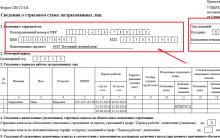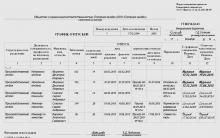Preparation of reports for statistical authorities, registration of tax benefits are routine procedures. In order not to make mistakes in the documents, it is necessary to carefully analyze the average number of employees. How to calculate this indicator for a month or a year, read the article.
From the article you will learn:
The number of hired personnel is an indicator that is taken into account when applying for tax and other benefits, compiling reports and certificates for supervisory authorities.
Question from practice
What periodic reports are prepared by the personnel service for government agencies?
Answered by Ivan ShklovetsDeputy Head of the Federal Service for Labor and Employment.
Reports on personnel topics are submitted to Rosstat, the employment service, the pension fund and the military registration and enlistment office. For example, a report in the form No. P-4 (NZ) is submitted to Rosstat quarterly, and a report on vacancies is submitted to the employment service on a monthly basis. Prepare…
Read the expert's answerIs there a difference between the average, list and average headcount
The average, list and average number of employees - three completely different indicators, in which, due to the similarity of names, even experienced personnel officers sometimes get confused. Let's figure out how exactly the average number for the tax and the average number of employees for the FSS differ, how to calculate each indicator.
Average population
When calculating the average headcount, all categories of employees are taken into account, including external part-time workers and contractors . The results obtained are used to control the number of personnel under the simplified and patent taxation system, as well as to determine the employer's right to UTII (single tax on imputed income).
Average headcount
When calculating the average headcount, other rules apply:
- External part-timers and freelancers for are not taken into account.
- Staff members with whom GPC agreements are additionally concluded, and only count once.
- Part-time workers (weeks) are counted in proportion to hours worked.
- Employees in do not count unless they continue to work from home or on conditions .
- Homeworkers are taken into account in full.
- Owners of the organization who receive a salary, as well as persons with whom with scholarships are not taken into account.
Details and clarifications for all categories of personnel can be found in . In standard forms of reports, annually, quarterly or once every several years, issued by employers for the Social Insurance Fund, statistical authorities and other authorities, this indicator often appears. Therefore, the personnel officer must know how to calculate the average number of employees: an example and detailed calculation rules are in the Instructions approved
payroll
The list refers to the number of employees as of a specific date - for example, on the first day of a calendar month. The same categories of personnel are taken into account as for the average indicator. Number of employees on automatically equate to the result of the previous working day.
Deadlines and rules for submission of mandatory reports:
-
What will help: timely prepare reports for the employment service, tax, pension fund, migration department and other bodies. -
What will help: fill out forms 57-T and 1-T for statistical bodies, avoiding a penalty for late submission of the report. -
What will help: correctly draw up and submit on time a report on part-time employment and the movement of workers according to the new P-4 form.
How to calculate the average number of employees per month
The average headcount per month is the sum of the payroll number of employees for each day from 1st to 30th (31st, 28th, 29th) days, divided by the total number of days of the month. Calendar days are taken into account, not working days, so weekends and holidays must also be taken into account ( ).
Editorial advice. In calculation of the average headcount include all employees who actually work in it, even if in accordance with they are registered at the head office or other representative offices of the company. This point of view is also shared by the Ministry of Finance of Russia (see. ).
How to correctly calculate the average number of employees per month? It follows from the payroll number of employees, determined using daily accounting documents. Make sure listings for all days of the month match the data and then apply the formula:
An example of calculating an indicator for a small organization without separate structural units for a month with 31 calendar days.
We take data on the headcount for all days of the month, including weekends and non-working holidays:

Some of the employees are in and maternity leave, therefore it is not included in the average headcount. We summarize only the data of the last column, we get 751. We substitute this number into the standard formula and calculate:
751: 31 = 24
If all employees of the organization work in a normal mode, there are usually no difficulties with counting. But in many companies there are employees who, for family reasons or other reasons, are placed . In this case, the calculation is carried out in proportion to the actual hours worked. First, the total number of man-days for this category is determined:
The next step is to determine the average headcount for the reporting month:
Note! This rule applies only to employees who have established a part-time regime, and not reduced working hours. who fall under the scope of Article 92 of the Labor Code of the Russian Federation, take into account in the usual manner - as full-time personnel.
How to calculate the average number of employees for the year
Every year, all organizations and individual entrepreneurs that attract hired personnel submit a report to the tax office in the form approved . It reflects the annual average number of employees: how to calculate (formula) this indicator is described below. Data are for the previous calendar year.
The form is formed as of January 1 of the current year, and if the organization is newly created or - on the first day of the month following the month of creation or reorganization of the employer. For the report in 2019, the average number of employees in 2018 will be required: how to calculate this indicator, the ready-made formula will tell you:
with a staff of several dozen people, based on data for all months of 2018:
A pivot table simplifies the data processing process and minimizes the risk of errors. We add up the indicators of the table and get 408. We substitute this number into the formula:
408: 12 = 34
The final result is entered in the annual report, as shown in the example:

If the company operates for a partial year, a similar formula is applied, adjusted for the length of the period of activity within the accounting calendar year:
In order to accurately calculate the average number of employees, rely on daily accounting data and take into account only the payroll categories of personnel. Exclude employees who are on maternity leave or study leave without pay. Do not include performers under civil law contracts and external part-time workers in either the payroll or the average headcount - calculate them separately.











How to issue a power of attorney to represent the interests of an LLC to an individual?
How to apply for an IP: step by step instructions
Form of power of attorney to receive goods or material assets
The deadline for registering an individual entrepreneur in the tax
Business plan for a law firm: an example with calculations legal support for a business